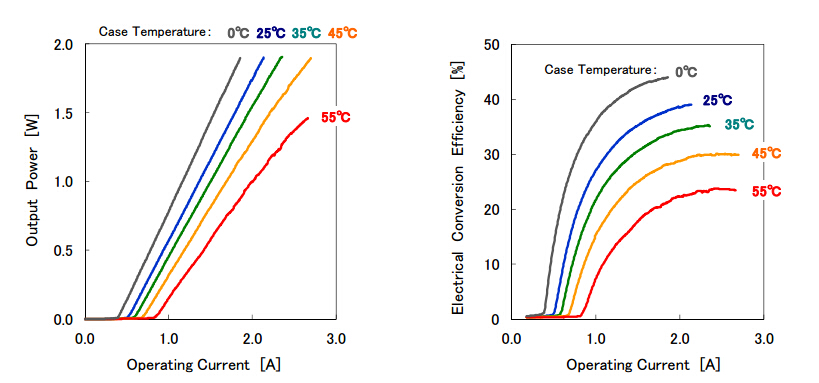Mitsubishi 638nm red laser diode for Projectors offering Industry's Leading Output, a 638nm red laser diode with output power of 1.8 W at continuous-wave operation, clicking the world’s highest level among the 638nm LDs. The 1800mW 638nm red laser ld can be used as a light source for projectors. The luminosity exceeds 220 lumens due to lasing at short wavelength. It's the most powerful red laser diodes in the world.
Furthermore, it has industry leading electrical conversion efficiency of 38% at 1.8 W at 25 degrees Celsius, resulting in reduction of power consumption. It offers excellent heat dissipation due to use of large TO-can package with diameter of 9.0 mm.
Specs:
Output Wavelength: 638nm 639nm
Output power: 1.8W 1800mW CW
Package: 9.0mm
Output Power: Average 1800mW,Max 2500mW
Working Current: 2800mA
Threshold current: 700mA
Operating voltage: 2.4V
Reverse Voltage: 2V
Package: TO-56 (9mm)
Operating temperature: 0 ~ + 55 ℃
Storage temperature: -40 to +85 ℃
Working life: more than 10,000 hours
Guarantee: 1 year
The diode is a new product, and we don't have the datasheet right now. Here are some reviews from the customers:
The diode has two emitters. Thus there are two beams at the output. We planned to use it for two applications. But as the divergence is very high (problem for the first application) and as there is a dark gap between the twou output beams (problem for second application) we can not use it.
TOKYO, June 17, 2014 – Mitsubishi Electric Corporation (TOKYO: 6503) announced today that it has developed a 638-nanometer (nm) wavelength red laser diode (LD) offering output power of 1.8 W at continuous-wave operation, the world’s highest level among 638-nm LDs in this package size used as light sources for projectors. A commercial launch is targeted for the fiscal year ending in March 2016 at which time laser light sources for projectors are expected to take off. The breakthrough LD will be presented during the Laser Display Conference 2014 (LDC 2014) at National Chung Hsing University in Taichung, Taiwan on June 19 and 20.
Light sources for color projectors, conventionally lamps, are being replaced with solid-state light sources offering higher energy efficiency, higher color reproduction and longer life. LDs deliver high output power while consuming low power because of their high power-conversion efficiency. Previously, the output power of red LDs with wavelengths shorter than 640 nm was not sufficient for high-brightness projector applications at high temperatures. As a first step to overcome this limitation, Mitsubishi Electric applied specialized window-mirror structures and epitaxial growth technology to develop an LD capable of 0.5 W power output at continuous-wave operation, which is packaged in a 5.6-mm-diameter transistor-outline can (TO-can). Thereafter, it applied a new LD structure in a 9.0-mm TO-can package to achieve industry-leading output power of 1.8 W at a 638-nm lasing wavelength, which meets demands for bright projector systems.
Features
1) Highest recorded output power of 1.8 W at 638 nm at continuous wave operation due to improved LD structure
- Achieves high output power in this package size due to the optimization of its layer structure and emitting-region size
- Continuous wave output power of 1.8 W, currently the world’s highest in the 638-nm band
- Luminosity as a red light source exceeds 220 lumens due to lasing at short wavelength
- Industry-leading electrical conversion efficiency of 38% at 1.8 W at 25 degrees Celsius, helping to reduce power consumption
2) Wide operational temperature range thanks to new package
- Good heat dissipation due to use of a large TO-can package with diameter of 9.0 mm
- Emits 1.8 W at continuous wave operation within an operating range of 0 to +45 degrees Celsius
- Emits 1.3 W at continuous wave operation above 55 degrees Celsius
Future Development
Going forward, Mitsubishi Electric plans to enhance its new LD’s high-power, low-consumption
characteristics, aiming at a commercial launch in the fiscal year ending in March 2016, at which time laser
light sources for projectors are expected to take off.
